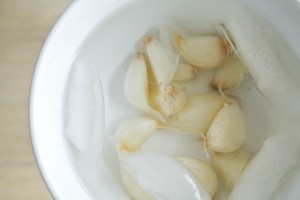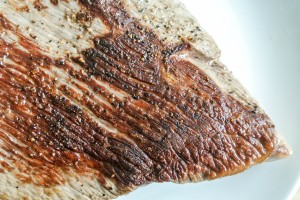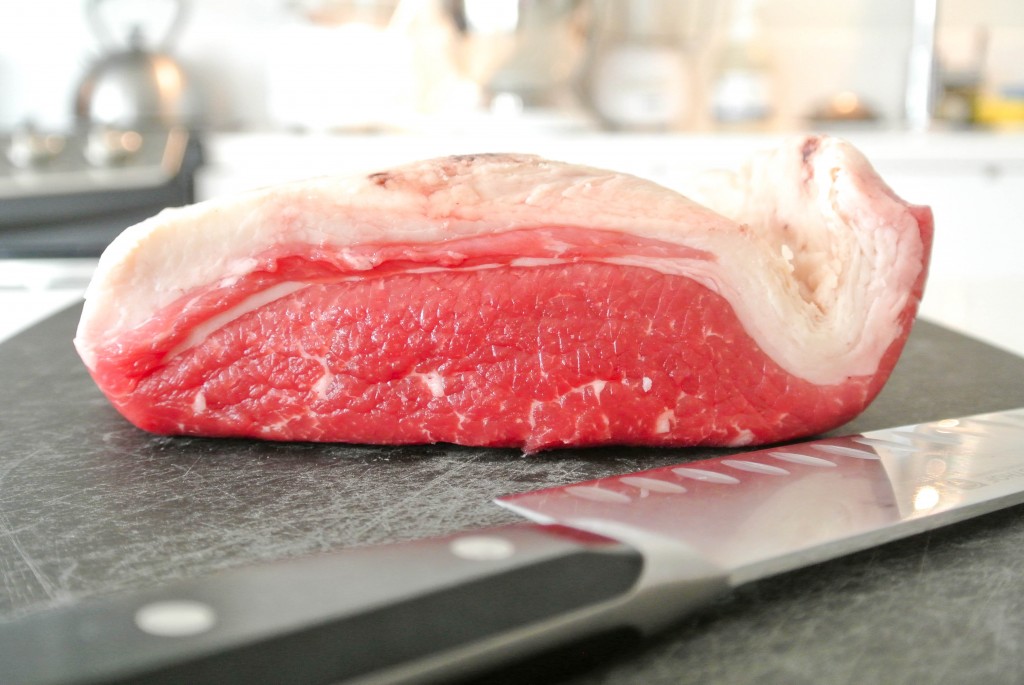Spring is (allegedly) just around the corner, but this winter brought with it many long, cold days. And for me, those days were excellent opportunities to spend some QT in the kitchen. Enter: this brisket. Braised in red wine, with garlic. What isn’t better with red wine and garlic?
I just moved in to a new apartment, and as I was packing up my old kitchen, I knew I wouldn’t be able to cook for a while. This brisket was the first major dish I made in my new place. I had been dreaming about it for weeks, and it delivered.
Brisket is not difficult to make, but it does take several hours, and several steps. If you have never made a brisket before, you may not know which cut of meat to purchase, and how much of it. So let’s start there.
I always recommend talking to the butcher at your local meat department when you have a question about meat. I don’t know why the butcher seems more intimidating than, say, the produce stockers – I mean, maybe it’s the enormous meat cleavers – but if butchers know one thing, it’s their meat! The cut you want to purchase is called “flat cut brisket” or “first cut brisket.” The first cut will have a great section of lean meat, and a thick fat padding that will add flavor while you are cooking (but it will cut off easily, if you wish, before you serve this dish). Not every store will have this cut of meat available all the time, so you may want to call first, or the next time you are in the meat aisle, just ask when they think they will have one in. If you want a brisket around any Jewish holiday, I recommend calling to ask if you need to reserve one – they are quite popular, and I do not recommend assuming there will be one available – lesson learned the hard way here! When they are gone, they are gone. {Note: Do not buy a seasoned corned beef, even if it looks like brisket!}
As far how much you should buy, it is hard to say, because if you ask me, you can never have too many leftovers! But I would say one pound will work out to about one serving (with a little left over). I never buy or cook less than 2.5 lbs, just for myself, and it lasts for a few meals. For a family of 4, I would recommend about 5 lbs, but note that a 5 lb brisket may not fit in your Dutch oven. If that happens, try cutting it in two pieces before you sear it.
See that thick layer of fat? We are just going to eat the lean bottom part, don’t worry. Take a look at the recipe below, where I discuss cutting off that piece of fat once the flavor has been extracted from it.
I could eat this every night. It is cooked with Cabernet, so try serving it with the same. Oh and some vegetables too.
Turns out brisket is also awesome for breakfast, with scrambled eggs!
- 1 head garlic, separated into cloves but not peeled
- 1 t kosher salt
- ½ t ground black pepper
- 3 lb flat cut (first cut) brisket {or about 1 lb per person}
- 2 T extra virgin olive oil
- 2 sweet onions, thinly sliced
- 3 c cabernet sauvignon {or other dry red wine}
- 2 T tomato paste
- 2 dried bay leaves
- 1 t dried thyme
- 4 c chicken broth or stock (boxed or home made)
- Fill a small saucepan with water, and bring to a boil.
- Prepare a small bowl filled with ice water.
- Add the garlic cloves and cook at a rapid boil for 1-2 minutes, until the garlic is slightly softened.
- Use a slotted spoon to transfer the garlic to a bowl of ice water and peel when cool enough to handle.

- Sprinkle the salt and pepper over the brisket.
- Heat the oil in a large oven-safe Dutch oven or heavy pot over medium-high heat until almost smoking.
- Add the brisket and sear, turning often, until well browned, about 6 to 8 minutes per side.

- Transfer the brisket to a plate or platter, but leave the fat that has been rendered in the pot. Leave the pot on the stove, and reduce the heat to medium.
- Add the onions and the peeled garlic to the pot.
- Sauté, stirring often, until golden, about 10 minutes.
- Pour in the wine, a little at a time, and stir to pick up any browned bits on the bottom of the pot.
- Stir in the tomato paste, and add the bay leaves and thyme.
- Increase the heat to high and bring to a boil.
- Cook rapidly, stirring often, until almost all the liquid has evaporated and the remaining mixture has thickened. This may take a half hour or more. {This is called "reducing" the wine - because it is being reduced in volume.}
- While the wine is reducing, place your oven rack so the pot will be in the bottom third of the oven, and preheat the oven to 325.
- Pour the chicken broth or stock into the pot, and bring back to a boil to incorporate the broth into the wine and onion mixture.
- Turn off the heat and return the brisket to the pot, fat side up, submerging it as much as possible under the liquid.
- Cover the open pot tightly with a piece of foil, and then cover the foil with the pot's lid.
- Transfer the pot to the oven, and cook until the meat shreds easily when you pierce it with a fork (the meat part, not the fat part). Be really careful when removing the foil - it will be very steamy inside!
This step will help you remove the fat all at once, so there isn't fat on every slice of meat
- Remove the brisket from the pot, and place on a piece of heavy-duty aluminum foil. Let it cool a bit, and then seal the foil tight.
- Refrigerate for at least 6 hours, and up to overnight (or, two if you get distracted). Refrigerate the red wine mixture in a separate container.
- Once the brisket has cooled, slice the fat off, leaving only the lean meat in one piece (or more, if it is very tender).
- Slice or shred the meat as you like it, and cover with the red wine mixture. Heat at 375 for 20-30 minutes, or until the sauce starts to bubble.

















[…] 17. Cabernet Brisket With Garlic This is an easy dish to make for one or two people (or as may as you like) because the recipe is written per pound/person. The wine gives this dish an elegant and classes taste, and is perfect combined with the flavor that comes from the sweet onions and garlic. […]